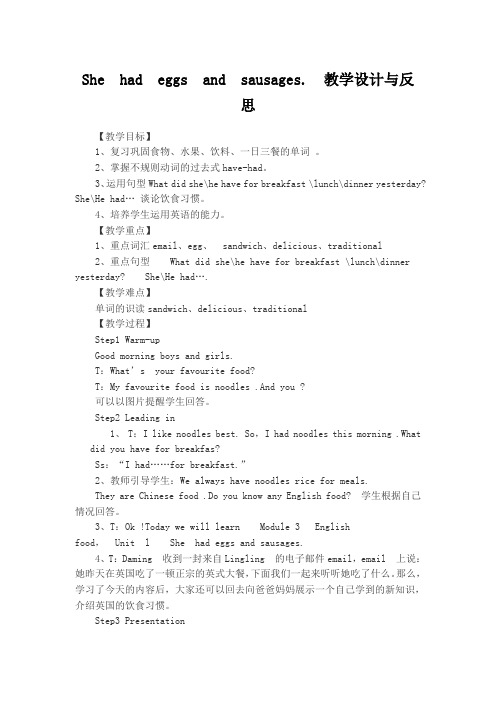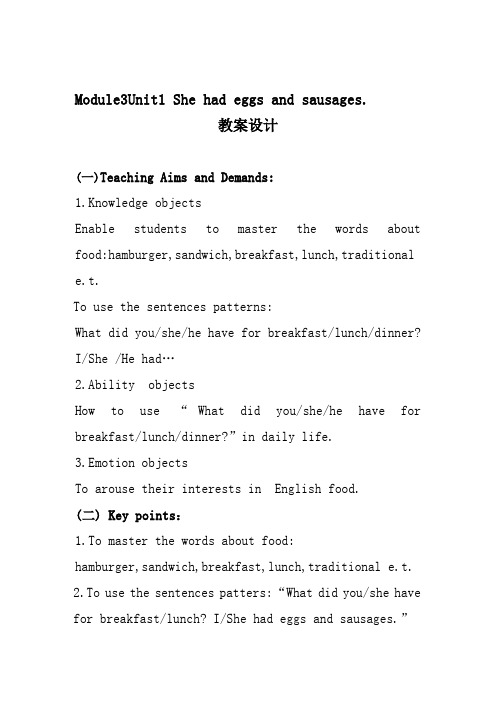She-had-eggs-and-sausages教学设计及反思 (1)
- 格式:doc
- 大小:79.50 KB
- 文档页数:3

Module 3 Unit 1 She had eggs and sausages.教学反思
本模块的主题是“English food”,主要内容是让学生运用一般过去时的特殊疑问句及答语来询问和表达一日三餐都吃了什么,了解掌握相关的英国传统食物名称并能谈论自己喜欢的和不喜欢的食物,引导学生了解最有益于健康、最科学的饮食结构,养成良好的饮食习惯。
在教学过程中引导学生自己发现问题、解决问题,教师指导学生学会自主分析和理解课文,构建以学生为主体的课堂教学模式。
本节课还突出以下两点:
1. 突出了学生的主体地位。
新课程主张以学生为主体,让学生做学习的主人,在这篇课文教学过程中,我充分尊重学生,始终让学生处于主体的地位,教师则更多地成了引导者、组织者,成为学生学习的好伙伴。
2. 另外在教学中,也通过游戏活动分散难度,降低难度,使学生积极参与,大胆实践,在愉快的游戏中不知不觉学到知识。

She had eggs and sausages. 教学设计与反思【教学目标】1、复习巩固食物、水果、饮料、一日三餐的单词。
2、掌握不规则动词的过去式have-had。
3、运用句型What did she\he have for breakfast \lunch\dinner yesterday? She\He had…谈论饮食习惯。
4、培养学生运用英语的能力。
【教学重点】1、重点词汇email、egg、sandwich、delicious、traditional2、重点句型What did she\he have for breakfast \lunch\dinner yesterday? She\He had….【教学难点】单词的识读sandwich、delicious、traditional【教学过程】Step1 Warm-upGood morning boys and girls.T:What’s your favourite food?T:My favourite food is noodles .And you ?可以以图片提醒学生回答。
Step2 Leading in1、T:I like noodles best. So,I had noodles this morning .Whatdid you have for breakfas?Ss:“I had……for breakfast.”2、教师引导学生:We always have noodles rice for meals.They are Chinese food .Do you know any English food? 学生根据自己情况回答。
3、T:Ok !Today we will learn Module 3 Englishfood,Unit l She had eggs and sausages.4、T:Daming 收到一封来自Lingling 的电子邮件email,email 上说:她昨天在英国吃了一顿正宗的英式大餐,下面我们一起来听听她吃了什么。

Module3Unit1 She had eggs and sausages.教案设计(一)Teaching Aims and Demands:1.Knowledge objectsEnable students to master the words about food:hamburger,sandwich,breakfast,lunch,traditional e.t.To use the sentences patterns:What did you/she/he have for breakfast/lunch/dinner? I/She /He had…2.Ability objectsHow to use “What did you/she/he have for breakfast/lunch/dinner?”in daily life.3.Emotion objectsTo arouse their interests in English food.(二) Key points:1.To master the words about food:hamburger,sandwich,breakfast,lunch,traditional e.t.2.To use the sentences patters:“What did you/she have for breakfast/lunch? I/She had eggs and sausages.”(三)Difficult points:How to use the sentences patterns: “What did you/she have for breakfast? I/She had eggs and sausages.” in the life.(四) Teaching methods:Task-based Language Teaching,Audio-visual mean,Real situation teaching method,Game Teaching method e.t. (五)Teaching aids:The computer, the word cards e.t.(六)Teaching procedures:Step 1.Warming up:1.Greetings.2.Let’s chant,“I like coffee.I like tea…”.Step 2 PresentationT:I had eggs and milk for breakfast this morning. Show the picture ,Learn and spell breakfast.1.Learn lunch.Spell in groups.2.Review dinner.3.S: I had …for breakfast.T: We always have noodles,dumplings and rice for meal,they are traditional Chinese food.Learn “traditional”tra-di-tional.4. Now let’s learn the English food.Learn English. Hamburger,show a picture and do the TPR.Show “Sandwich”picture and spell “Sandwich”【Emphasis】Plural Forms add “-es”,sandwiches. Fish and chips show a card and learn it.Remember “chips”in groups.Dish fish and chips is a traditional English dish.5 In order to remember the words, I Use “say it in an opposite voice,bombing game, missing game”e.t. Step 3 New teachingActivity 1 Read the chant.(Activity 1 is in Book 6) Translate the chant,girls read,boys translate.Say the chant together.Activity 3 Practice.(Activity 3 is on Page 16 in Book6) 1.T:What did you have for breakfast?LunchDinnerS1:I had…T:What did you have for lunch?S2: I had…Let Ss work in pairs,ask and answer.2. Retail the words that students speak.T:She/He had...Ss: She/He had...T:Good.What did she/he have for breakfast yesterday? lunchdinnerSs: She/He had...3.Work in pairs,communicate with the sentences.petition of saying the sentences.Let two students PK.Step 4 Practice and summary.1. Have a 4dictation ,let a student write down the words on the blackboard.2.Reporter game.Interview the meals of your good friends.3. Make a healthy menu.Step 5 Homework.1.Introduce English food to your parents.2.Go on making a healthy menu.That's all.Thank you.Blackboard designing:Unit1 She had eggs and sausages.A:What did she/you have for breakfast yesterday?lunchdinnerB:She/I had hamburger.sandwich学情分析根据五年级学生心理认知能力特点,教师在教学设计过程中要充分体现出目标明确、教学过程循序渐进、强化学生听说能力、侧重学生语言学习习惯和读写能力养成的教学特点。

She Had Eggs and Sausages 教学设计教案教学目标:1. 学生能够理解和使用过去式动词"had" 来描述过去发生的动作。
2. 学生能够理解和使用早餐食物相关的词汇,如"eggs" 和"sausages"。
3. 学生能够通过听、说、读、写的活动,提高英语语言技能。
教学内容:1. 教学单词:eggs, sausages2. 教学句子:She had eggs and sausages.3. 教学时态:过去式动词"had"教学步骤:一、导入(5分钟)1. 教师与学生问候,介绍本节课的主题:早餐。
2. 展示早餐食物的照片,引导学生说出相关词汇,如"eggs" 和"sausages"。
二、新课呈现(10分钟)1. 教师展示故事图片,引导学生预测故事内容。
2. 教师朗读故事,引导学生关注主角的早餐内容:"She had eggs and sausages."3. 教师引导学生重复句子,并解释过去式动词"had" 的用法。
三、活动一:小组讨论(10分钟)1. 学生分组,讨论他们自己早餐的食物。
2. 每组选择一种早餐食物,用"She had" 的句型来描述。
四、活动二:角色扮演(10分钟)1. 教师准备角色扮演卡片,上面有不同的早餐食物和动词。
2. 学生抽取卡片,根据卡片上的内容进行角色扮演,使用"She had" 的句型。
五、总结与作业(5分钟)1. 教师引导学生回顾本节课所学的单词和句子。
2. 布置作业:让学生写一篇关于自己早餐的小作文,使用"She had" 的句型。
教学评估:1. 在小组讨论和角色扮演活动中,观察学生的参与度和语言运用能力。
2. 收集学生的作业,评估他们对"She had" 句型的理解和运用情况。

《Unit 1 She had eggs and sausages》教学设计一、教材分析:本教材是外研版小学英语五年级下册Module 3 Unit 1 She had eggs and sausages,主要围绕着食物和过去完成时态展开。
学生在前几个单元已经学习了一般过去时的用法,本单元通过对过去完成时的学习,进一步提高学生的语言运用能力。
二、教学目标:1. 学会正确使用过去完成时态,描述过去发生的动作。
2. 学会用英语表达食物名称,并能正确使用句型"She had..."。
3. 培养学生的听说能力,通过对话和练习,提高学生的语言表达能力。
三、教学重点和教学难点:教学重点:过去完成时态的用法和句型"She had..."教学难点:正确使用过去完成时态描述过去发生的动作四、学情分析:学生已经学习了一般过去时的用法,对过去时态有一定的了解。
他们对食物名称可能已经有了一定的掌握,但对过去完成时态的用法和句型还不熟悉。
五、教学过程:Step 1: Warm-up1. Greet the students and engage them in a short conversation about their favorite foods.- Teacher: Good morning, everyone! How are you today? Let's talk about food. What's your favorite food?- Students: My favorite food is pizza/sushi/ice cream, etc.2. Review the vocabulary of food items learned in previous units by showing pictures of different food items and asking students to name them in English.- Teacher: Now, let's review some food vocabulary. Look at the pictures on the board and tell me what they are in English.- Students: It's a hamburger/an apple/a bowl of noodles, etc.Step 2: Presentation1. Introduce the concept of past perfect tense by explaining that it is used to talk about an action thathappened before another action in the past.- Teacher: Today, we're going to learn about the past perfect tense. The past perfect tense is used to talk about an action that happened before another action in the past. For example, "She had already eaten breakfast before she went to school."2. Give examples of sentences using past perfect tense and explain the sentence structure.- Teacher: Let's look at some examples. "She had finished her homework before she watched TV." "He had already bought the tickets before the concert started." In these sentences, the past perfect tense is formed by using "had" followed by the past participle of the verb.- Teacher writes the sentence structure on the board: Subject + had + past participle.Step 3: Practice1. Provide students with a worksheet containing sentences in the past perfect tense.- Teacher: Now, let's practice using the past perfect tense. Here, I have a worksheet for each of you. Please read the sentences and fill in the blanks withthe correct form of the verb in brackets.2. Ask students to complete the sentences individually. - Teacher: Take your time to complete the worksheet. If you have any questions, feel free to ask.3. Monitor the students' progress and provide assistance when needed.- Teacher: How are you doing? Do you need any help? Step 4: Listening and Speaking1. Play an audio recording of a conversation between two people talking about their breakfast.- Teacher: Now, let's listen to a conversation between Tom and Sarah. They are talking about what they had for breakfast. Listen carefully and answer the questions I will ask afterward.2. Ask students to listen and answer questions about what each person had for breakfast.- Teacher: What did Tom have for breakfast? What did Sarah have for breakfast?3. Divide the students into pairs and ask them to havea similar conversation about their own breakfast using the past perfect tense.- Teacher: Now, I want you to work in pairs. Taketurns asking and answering questions about what you had for breakfast using the past perfect tense. Use the sentence structure we learned earlier.- Students practice the conversation in pairs. Step 5: Consolidation1. Write the sentence pattern "She had..." on the board. - Teacher: Let's review the sentence pattern we learned today. Look at the board. The pattern is "She had..." Now, I want each of you to create your own sentence using this pattern.2. Ask students to create their own sentences using the pattern and share them with the class.- Teacher: Think about something you did before another action in the past. Write a sentence starting with "She had..." and share it with the class.- Students share their sentences with the class.3. Provide feedback and correct any errors.- Teacher: Great job, everyone! Now, let's go through some of the sentences you created. (Provides feedback and corrects any errors if necessary.)Step 6: Extension1. Show pictures of different food items and askstudents to describe what they had for breakfast using the past perfect tense.- Teacher: Look at these pictures of different foods. Choose one of them and describe what you had for breakfast using the past perfect tense.- Students take turns describing their breakfast using the past perfect tense.Step 7: Wrap-up1. Review the key points of the lesson, emphasizing the use of the past perfect tense and the sentence pattern "She had..."- Teacher: Today, we learned about the past perfect tense and how to use it to talk about actions that happened before another action in the past. We also practiced using the sentence pattern "She had..." to describe past events. Well done, everyone!2. Assign homework, which could include writing a short paragraph about what the students had for breakfast using the past perfect tense.- Teacher: For homework, I want you to write a short paragraph about what you had for breakfast today. Use the past perfect tense to describe what happened beforeanother action in the past.六、板书设计:She had eggs and sausages.Past Perfect TenseShe had + past participle七、教学反思:本节课通过引入过去完成时态,帮助学生进一步巩固和扩展他们的语言知识。

Module 3 Unit 1 She had eggs and sausages(教案)- 2022-2023学年英语五年级下册一、教学目标1.词汇:eggs, sausages, different kinds of food, breakfast, lunch, dinner。
2.句型:She had eggs and sausages for breakfast. She had milk and bread for breakfast.3.能够听、说、读、写不同的食物,以及三种餐食名称。
二、教学重难点1.句型:“She had…”要求学生学会用相应的食物名词来替换。
2.“Different kinds of food”短语的表达。
3.能够听懂并说出三种餐食名称。
三、教学准备1.PPT。
2.卡片(上面写着不同的食物和餐食名称)。
四、教学过程1. Warming up通过图片和声音“叮铃铃,叮铃铃!”来唤起学生对餐食的兴趣。
PPT中可以加入有关食物的图片,增加兴趣。
2. Presentation•使用PPT例句演示:“She had eggs and sausages for breakfast.”这句话的意思。
然后使用不同的食物替换这句话中的“eggs and sausages”,让学生了解这句话的一般表达方式。
•向学生展示“Different kinds of food”这个短语,并组织学生一起说出相应的食物名称。
•教师出示一份餐食菜单,让学生看一看这个菜单,并询问他们觉得哪些食物应该在哪一餐食中出现。
让学生使用他们已经学过的“breakfast, lunch, dinner”三种单词,来回答问题。
3. Practice•教师变换语序,要求学生使用模仿的语言表达相同的意思。
“For breakfast, she had bread and milk.”再次使用不同的食物替换“bread and milk”。
====Word行业资料分享--可编辑版本--双击可删====小学英语第六册(外研版)Module 3 Unit 1 She had eggs and sausages.教学反思本节课的目标是让学生在对话中感知一般过去时的语境,让学生用What did she have for breakfast/ lunch/ dinner? She had ...学习询问一日三餐吃了什么及回答;培养学生实际运用语言的能力,使学生的听、说、读、写能力得到提高。
围绕这两个主要目标,我进行了精心的设计:五年级的学生具备了一定的英语基础和自学能力,因此,本课遵循了课前预习、课内探究、课后延伸三个步骤。
在讲授之初,我布置预习任务;在讲授过程中,我设计游戏复习单词和练习句型,激发他们的学习兴趣,唤醒他们的学习潜能;将学习任务分割成三个部分着重解决,构建学习梯度,降低学习难度。
在课后布置课后自由调查的作业。
目的在于理解对话,把握重点,自由输出。
反思本节课,我感觉比较成功的地方:1.课前交流,复习导入:在大屏幕上呈现大量已学食物的单词,用快闪的方式刺激孩子们的感官,激发他们的兴趣。
还能够将新旧知识结合在一起,是孩子们自然的接收本节课的英式食物,微雨燕的训练奠定基础。
2.在对话部分分段听读完毕,我将重点句型设计成chant并配动感音乐。
chant朗朗上口,再次激发孩子们的兴趣,在节奏感十足的旋律中,孩子们很自然的、快速的接受了新知识。
不足之处:1.本节课的主题是英式饮食,可以再对英国食物进行更多拓展,由于考虑到学生的实际差异,没有进行大胆尝试,可以在介绍中国传统饮食处与英式饮食作对比,或者在作业布置时涉及到查找资料环节。
以后会在教学中尝试大胆改进课堂教学。
2.在对话及游戏环节,有的孩子因为害怕说错,所以不敢去争取机会。
我并没有用鼓励语将这部分学生评价到位。
因此,针对不同的学生采取不同的评价又对我的教学提出了更高的要求,这也是我今后教学中应该着重考虑的。
教案:She had eggs and sausages教学目标:1. 学生能够理解和使用过去式动词“had”来描述过去发生的动作。
2. 学生能够理解和使用名词“eggs”和“sausages”来描述食物。
3. 学生能够理解和使用代词“she”来指代第三人称单数女性。
教学重点:1. 过去式动词“had”的用法。
2. 名词“eggs”和“sausages”的用法。
3. 代词“she”的用法。
教学难点:1. 过去式动词“had”的构成和用法。
2. 名词“eggs”和“sausages”的拼写和用法。
教学准备:1. 教学PPT或者黑板。
2. 食物图片或者实物。
3. 人物图片或者实物。
教学过程:一、导入(5分钟)1. 教师向学生问候,并引导学生回顾过去学过的动词和名词。
2. 教师提问学生:“你们记得我们学过哪些动词吗?哪些名词?”3. 学生回答,教师给予肯定或纠正。
二、新课介绍(10分钟)1. 教师出示食物图片或者实物,引导学生说出“eggs”和“sausages”。
2. 教师讲解过去式动词“had”的构成和用法,并举例说明。
3. 教师出示人物图片或者实物,引导学生使用代词“she”来描述。
三、课堂练习(10分钟)1. 教师给出句子:“She had _____ and _____ for breakfast.”,让学生填入正确的名词。
2. 学生回答,教师给予肯定或纠正。
3. 教师给出句子:“_____ had eggs and sausages for breakfast.”,让学生填入正确的人称代词。
4. 学生回答,教师给予肯定或纠正。
四、小组活动(10分钟)1. 教师将学生分成小组,每组三人。
2. 每组轮流扮演不同角色,使用“She had eggs and sausages for breakfast.”这个句子进行对话。
3. 教师巡回指导,纠正发音和用法错误。
五、总结与作业(5分钟)1. 教师引导学生总结本节课所学的知识。
She Had Eggs and Sausages 教学设计-教案第一章:教学目标1.1 学生能够理解并运用目标句型"She had" 描述某人吃了什么。
1.2 学生能够听懂、说出口语指令"She had"。
1.3 学生能够通过听力、口语、阅读和写作等多种方式,提高英语语言综合运用能力。
第二章:教学重难点2.1 重点:目标句型"She had" 的结构及用法。
2.2 难点:目标句型的听说读写综合运用。
第三章:教学准备3.1 教学材料:教材、多媒体设备、实物食物图片、食物卡片等。
3.2 教学环境:教室里摆放一些食物模型或实物,营造轻松的学习氛围。
第四章:教学过程4.1 热身活动(5分钟):引导学生谈论他们最喜欢的食物,激发学生对食物的兴趣。
4.2 引入新课(10分钟):通过展示食物图片,引导学生说出"She had" 的句型,例如:"She had eggs.","She had sausages." 等。
4.3 实践环节(10分钟):学生分组,互相练习使用"She had" 句型描述对方吃了什么。
教师巡回指导,纠正发音并给予鼓励。
4.4 巩固环节(10分钟):通过角色扮演活动,让学生模拟在餐厅点餐的场景,运用"She had" 句型进行交流。
4.5 总结环节(5分钟):教师简要回顾本节课所学内容,强调"She had" 句型的用法。
第五章:作业布置5.1 作业1:学生回家后,观察家人或朋友的晚餐,用"She had" 句型写出他们吃了什么。
5.2 作业2:学生选择一种食物,用"She had" 句型制作一个简单的海报,介绍这种食物。
第六章:教学评估6.1 评估方式:课堂观察、口头提问、作业批改。
教学设计一、教学目标(一)知识目标:1. 听懂会说单词egg email sandwich traditional delicious2. 能够听懂、会说目标语句:What did she have for lunch? 并能口头运用She had sandwiches 这类语句回答有关询问。
(二)技能目标:1. 学生能够在创设的情景中对别人吃过什么进行较流畅的问询和回答。
2.能够能灵活运用功能语句在真实的生活情景中调查并转述别人的饮食习惯。
(三)情感目标:1.学生在多种教学资源中体验和感受英国饮食文化,激发学生探究的兴趣;2.学生能够在看、听、想、说、写中发展多元智能,养成认真倾听的好习惯,并在小组讨论交流汇报中体验合作竞争的带来的收获与快乐。
二、教学重难点能在真实情境中熟练运用目标语句:What did she have forbreakfast/lunch/dinner? She had…三、教具: PPT, word cards.四、教学过程一、warm-up:(热身)1、Greetings2、Look and say show some pictures of food (rice meat noodles bread milk eggsfish)T:so many delicious food.教授单词delicious3、Free talk T:what is your favourite food? Ss: My favourite food is...二、Leading in (导入)1、work in groups and talk about your favourite food.(4 in groups)2、Show in groups.T:My favourite food is eggs and noodles.so I had eggs and noodles for breakfast.引出单词并教授breakfast,贴到黑板上。
Unit1 She had eggs and sausages.
教案背景
1,小学英语第六册第三模块第一单元
2,课时:1
3,学生课前准备:
1)、复习食物、饮料类词汇。
2)、预习课文。
教学目标
1、复习巩固食物、水果、饮料、一日三餐的单词
2、掌握不规则动词的过去式have-had。
3、运用句型What did she\he have for breakfast \lunch\dinner yesterday? She\He had….谈论饮食习惯。
4、培养学生运用英语的能力。
教材分析
本课是新标准英语三起点五年级下册第三模块第一单元。
本单元通过Daming收到的一封电子邮件,提出了英国人的用餐习惯,以及向别人询问昨天一日三餐吃过什么的具体表达方法。
教学重点:
(1)重点词汇email ,egg, sandwich,delicious,traditional
(2)重点句型What did she\he have for breakfast \lunch\dinner yesterday? She\He had….
教学难点:
单词traditional的发音。
教学方法
为了形象直观,在教学中我运用了实物和图片教学。
反复训练食物的词汇。
同时运用提问的方式,反复训练重点句型。
收到了预期的教学效果。
五、教学过程
Unit1 She had eggs and sausages
Step 1Warm-up
课前听唱歌曲
/u82/v_NjM1ODcxOTk.html
1师生一起朗诵有关食物的chant
2、在黑板上写出Food这个单词,四人一组在规定的时间内写出他们所知道的食物,比比看哪个小组说的单词多,其他小组可以补充。
用同样的方法练习水果和饮料。
3、教师呈现食物:eggs、sandwiches、fish and chips作为自己喜欢的食物提出,课件出示图片教学新单词。
Step2 Presentation(新课呈现)
活动一
1、教师向学生提出问题:What did you have?” 教师请一名学生回答,:然后再请其他同学转述该生的回答:“He/She had…… for breakfast.”
2、小组内开展“街头采访”的游戏。
其中一位同学扮演小记者,向其他成员提问:What did you have for breakfast/lunch/ dinner yesterday? 被采访的同学用:I had …… for ……yesterday .来回答。
请每组派代表到前面来表演,选出优秀小记
者。
3、教师提示She\He had a traditional Chinese breakfast.学习traditional,出示课件让学生了解traditional的含义。
4、教师小结:We always have noodles、dumplings and rice for meals .They are Chinese food. Lingling昨天在英国吃了什么?让我们一起去看看吧。
Step3 text
课件出示课本中的插图,播放课文录音。
请学生合上课本,边看插图边听录音,听一听Lingling在电子邮件中提到了哪些英国食物。
2、请学生打开课本,教师再放录音,让学生边听边画出听到的有关食物的单词。
3、请学生合上课本,教师出示课件,让学生带着问题再听课文
问题:(1) What did Lingling have for breakfast?
(2)What did Lingling have for lunch
(3)What did Lingling have for dinner?
(4)Does Lingling like English food
4、学生理解了课文内容之后,教师再次播放录音,请学生逐句跟读。
然后把全班分为两组,分角色朗读对话,教师对学生的语音语调进行指导。
Step4.Practice
句子接龙,训练重点句。
S1:What did you have for breakfast yesterday?
S2:I had eggs and milk.
S2:What did you have for lunch?
S3:I had rice and meat.
S3:And what did you have for dinner?
S4:I had noodles.
2.小组展示,其余同学做好记录。
过后,学生根据记录回答问题。
A: What did he/she have for breakfast yesterday?
B:He/She had……
A: What did he/he have for lunch yesterday?
B:He/She had……
A:What did he/she have for dinner yesterday?
B:He/She had ……
Step 4 homework
查阅资料,了解中西方早、中、晚餐不同的饮食习惯。
板书设计:
Unit1 She had eggs and sausages
一、email ,egg, sandwich,delicious,traditional
二
What did she\he have for breakfast \lunch\dinner yesterday? She\He had…
教学反思
1. 突出了学生的主体地位
新课程主张以学生为主体,让学生做学习的主人,在这篇课文教学过程中,我充分尊重学生,始终让学生处于主体的地位,教师则更多地成了引导者、组织者,成为学生学习的好伙伴。
2. 在教学中,我通过大量的游戏活动分散难度,降低难度,使学生积极参与,大
胆实践,在愉快的游戏中不知不觉学到知识。